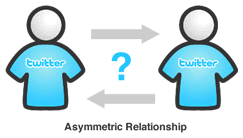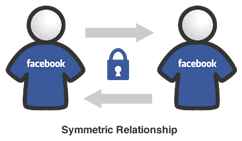Relationship Symmetry in Social Networks: Why Facebook will go Fully Asymmetric
A description of symmetry and how it affects relationships in social networks. Also, a prediction that Facebook will eventually go asymmetric.
Recent events have made it clear that Facebook sees Twitter as a serious threat to its business. First, Facebook tried to buy Twitter for $500,000,000 in stock. Twitter declined. Facebook then began describing their service in increasingly-twitter like ways, such as during the Inauguration when they showed a “live stream” of chatter alongside CNN news. And on March 11 Facebook redesigned their homepage (the logged-in homepage) to a layout remarkably similar to Twitter. As Twitter’s growth continues to accelerate, it is obvious that Facebook is trying to block Twitter from catching up.
In addition, Facebook redesigned their Pages feature. The pages feature is “a customizable presence for an organization, product, or public personality to join the conversation with Facebook users”. The pages feature will now become more like a personal profile, with status updates from a Page showing up in people’s news feeds. For example, if someone from the New York Times updates the status of the NYT Page, then a corresponding notification will show up on the news feed of all the Facebookers who have identified themselves as “fans” of the NYT Page. In this way entities with Pages (organizations, products, & public personalities) can essentially broadcast messages to their fan base.
This, of course, is how Twitter works. The difference is that on Twitter this is the default behavior for everyone, not just special entities. And on Twitter the term is “following”, not “fan”.
Relationship Symmetry

In general, there are two ways to model human relationships in software. An “asymmetric” model is how Twitter currently works. You can “follow” someone else without them following you back. It’s a one-way relationship that may or may not be mutual.

Facebook, on the other hand, has always used a “symmetric” model, where each time you add someone as a friend they have to add you as a friend as well. This is a two-way relationship, and it is required to have any relationship at all. So as a Facebook user there is always a 1-1 relationship among your friends. Everyone who you have claimed as a friend has also claimed you as a friend.
Andrew Chen recently described one advantage of the Twitter model. It allows 4 types of relationships, while Facebook only allows for two. The two relationships of Facebook are “friend and Not Friend”. The four relationships of Twitter are:
- People who follow you, but you don’t follow back
- People who don’t follow you, but you follow them
- You both follow each other (Friends!)
- Neither of you follow each other
Attention Inequality & the Power of Asymmetry
As Andrew points out, an asymmetric model allows for more types of relationships. I think the benefits go further than that. I think that the asymmetric model better mimics how real attention works…and how it has always worked. Any person using Twitter can have a larger number of followers than followees, effectively giving them more attention than they give. This attention inequality is the foundation of the Twitter service…
Note that this is a structural concern of the software, not just a philosophical leaning. The information architecture (IA) of the Twitter service was designed in such a way to do this from the start. The IA of Facebook does not allow this. In a similar way the structure of a building determines the activity of those who enter it, the structure of social networking software determines the activity of those who use it. And from these initial, structural decisions the future of the services are, at least partially, determined.
As I noted above, for some entities on Facebook the relationship is asymmetric. But for the vast majority of “regular” people using the service (i.e. You and Me), it is not. Facebook has designed a service that forces you to keep track of your friends, whether you want to or not. 🙂
Facebook’s stated goal is to model the social graph. By this they mean that they want to model the relationships between all people. If you have a friend in meat space, they want to model it in software. But it has become increasingly clear that Facebook is modeling personal relationships, not relationships based on attention. That’s the crucial difference between Facebook and Twitter at the moment.
I have approximately twenty times more Twitter followers than I do Facebook friends (Me on Twitter | Facebook). I doubt I could ever have as many friends on Facebook as followers on Twitter, because if I did I would have to pay attention to all of them, all of the time. On Twitter I don’t even try to follow everyone because I don’t have enough attention to do so (I tend to follow people I’ve met). Similarly, many of the people I follow don’t follow me back. Why would they?
For the most part, if you use Twitter you accept this discrepancy. This is how attention works. Imagine if the musician John Mayer had to pay attention to all of the 422,877+ people who follow him on Twitter (he currently follows 20). He would immediately be overwhelmed. Seriously, if an full-blooded American male can’t even pay attention to Jennifer Aniston, we see how dire this entire situation has become.
We understand that attention is often one-way. While we would be angry if our friends ignored us…we are mostly fine with the fact that Tina Fey doesn’t return our dozens of phone calls.
Why Facebook will go Fully Asymmetric
I predict Facebook will soon go fully asymmetric, allowing all users of the system (not just celebrities or companies) to have “follower” relationships that don’t require reciprocation. I believe they will once again follow in Twitter’s footsteps and people will be able to have follower lists that are much bigger than the number of people they follow.
I don’t know how they’ll do this, my guess is they’ll attempt to keep both systems intact. They’ll keep the friends designation for symmetric relationships, but also add another asymmetric capability. It would probably be best to use the term “follow” for this, but they may continue to keep the term “fan”, even though being a fan of another individual sounds a bit silly…the term “follower” is better.
Facebook will announce this publicly in their common way, by saying their goal is to help you connect to your friends and family better. They’ll say they’ve realized that there are many relationships that aren’t as strong as mutual friends but are nonetheless important…and therefore they’ve hit upon this wonderful new functionality for you…and they’ll somehow recast it as “Open” in some way…and blah blah blah. Pundits will point out how they’re copying Twitter. Robert Scoble will say it’s brilliant and remind us Zuck just doesn’t care what people think. Users will revolt by creating a “Facebook Users Against Fan Designation” group and it will quickly grow to 1 million members. The actual design of the system will hardly come up. Ev Williams will probably tweet something completely unrelated. You know. The usual.
The real reasons why Facebook will go asymmetric are reach (growth) and data.
Facebook will grow their service by allowing people to accrue attention in a way they can’t currently in the system. People will realize the same benefits they currently do on Twitter…you can actually start to have an audience that is larger than your current friends list. In other words, this will allow members of Facebook to have a much larger reach than they could before…thus giving Facebook a larger reach as well. This will be the next big growth spurt for Facebook, who has executed so well on almost everything they’ve done so far…but at the present moment the structure of the system prevents this from happening.
In short, Facebook will improve the ability of its members to accrue social capital within the system. And, if you aren’t familiar with this notion, check out Yochai Benkler’s The Wealth of Networks, which lays out in excellent detail why social capital is the wealth of networks. He also describes the way humans have trouble with exchanging social capital with economic capital. (this exchange is the nut Facebook and other social networks are trying to crack)
The second reason Facebook will go asymmetric is that this will mean more data. While personal relationship data must be extremely valuable, this additional attention data is being left on the table. As Tim O’Reilly foresaw in his 2005 What is Web 2.0 post, and what huge players Google and Amazon know intimately, is that data is an increasingly important asset.
I would guess that this is why Twitter isn’t too worried about building revenue quite yet…they know how important people’s followers are to them. Hearken back to the few days last fall when follower numbers were going wonky…twitterers were up in arms! The attention Twitterers have accrued in their followers is worth serious cash. Imagine the effort of rebuilding your follower list. For example, it would take me 20 times as long to build my Twitter list as it would rebuild my Facebook friends list! That’s worth money. A lot of money.
What of Other Networks?
My good friend Christina Wodtke and I discussed this a lot at the recent IA Summit. Christina works for LinkedIn, whose relationship model is symmetric like Facebook’s. She told me that LinkedIn are *always* thinking about these issues; they obsess over the ability of their users to connect and improve relations with others. There is probably similar obsession over at MySpace, and Bebo, and well…just about any social network. My guess is that all players in this space have to be looking at the Twitter model and thinking about how they might adopt it in some way.
Where is your money?
Given their recent attempt to buy Twitter, their not-so-subtle copying of the Twitter interface, and the tweaks to the Pages feature, my money is on Facebook moving to a asymmetric relationship model in the very near future. I think their current structure has served them well, but when they look at Twitter’s growth curve, they can’t help but wonder what an asymmetric structure would do to improve their own.
Further Reading:
- Adina Levin of Socialtext adds some interesting thoughts on why asymmetry scales better.
- James Governor has a nice post on the asymmetric relationship pattern.
- Om Malik suggests that Facebook is facing an identity crisis
